
The geography of Italy includes the description of all the physical geographical elements of Italy. Italy, whose territory largely coincides with the homonymous geographical region, is located in southern Europe and comprises the long, boot-shaped Italian Peninsula crossed by the Apennines, the southern side of Alps, the large plain of the Po Valley and some islands including Sicily and Sardinia. Italy is part of the Northern Hemisphere. Two of the Pelagie Islands are located on the African continent.

The Mediterranean Sea is a sea connected to the Atlantic Ocean, surrounded by the Mediterranean Basin and almost completely enclosed by land: on the north by Western and Southern Europe and Anatolia, on the south by North Africa, and on the east by the Levant. The Sea has played a central role in the history of Western civilization. Although the Mediterranean is sometimes considered a part of the Atlantic Ocean, it is usually referred to as a separate body of water. Geological evidence indicates that around 5.9 million years ago, the Mediterranean was cut off from the Atlantic and was partly or completely desiccated over a period of some 600,000 years during the Messinian salinity crisis before being refilled by the Zanclean flood about 5.3 million years ago.

Spain is a country located in southwestern Europe occupying most of the Iberian Peninsula. It also includes a small exclave inside France called Llívia, as well as the Balearic Islands in the Mediterranean, the Canary Islands in the Atlantic Ocean 108 km (67 mi) off northwest Africa, and five places of sovereignty on and off the coast of North Africa: Ceuta, Melilla, Islas Chafarinas, Peñón de Alhucemas, and Peñón de Vélez de la Gomera.
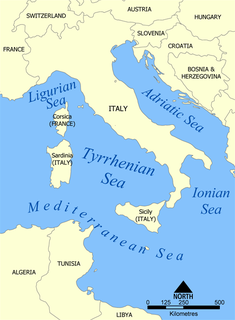
The Tyrrhenian Sea is part of the Mediterranean Sea off the western coast of Italy. It is named for the Tyrrhenian people identified with the Etruscans of Italy.
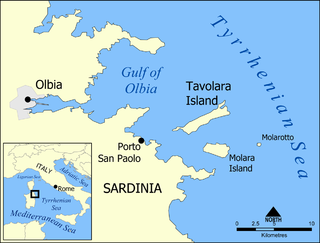
Tavolara is a small island off the northeast coast of Sardinia, Italy. The island is a limestone massif 5 kilometres long and 1 kilometre wide, with steep cliffs except at its ends. Its highest point, Monte Cannone, is 565 metres above sea level. A cove and beach can be found at each end of the island, Spalmatore di Fuori at the northeast, and Spalmatore di Terra at the southwest. Currently, the island is inhabited by only a handful of families, and has a small cemetery and summer restaurant. The water around the island is a popular spot for scuba diving.
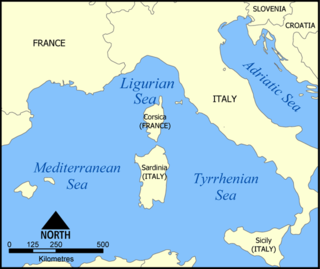
The Ligurian Sea is an arm of the Mediterranean Sea. It lies between the Italian Riviera (Liguria) and the island of Corsica. The sea is thought to have been named after the ancient Ligures people.

The Halmahera Sea is a regional sea located in the central eastern part of the Australasian Mediterranean Sea. It is centered at about 1°S and 129°E and is bordered by the Pacific Ocean to the north, Halmahera to the west, Waigeo and West Papua to the east, and the Seram Sea to the south. It covers about 95,000 km (59,000 mi) and its topography comprises a number of separate basins and ridges, the chief of which is the Halmahera Basin reaching a depth of 2039 m.

The Balearic Sea is a body of water in the Mediterranean Sea between the Balearic Islands and the mainland of Spain. The Ebro River flows into this small sea.

Hispania Balearica was a Roman province encompassing the Balearic Islands off the east coast of modern Spain. Formerly a part of Hispania Tarraconensis, Balearica gained its autonomy due to its geographic separation and economic independence from the mainland. The province included three major islands: Balearis Major (Majorca), Balearis Minor (Minorca), and Ebusus (Ibiza), and the small island of Colubraria or Ophiusa (Formentera). The islands were grouped as the Gymnesiae—Majorca and Minorca, and the Pityusae—Ibiza and Formentara.

The Republic of Pisa was an independent state centered on the Tuscan city of Pisa, which existed from the 11th to the 15th century. It rose to become an economic powerhouse, a commercial center whose merchants dominated Mediterranean and Italian trade for a century, before being surpassed and superseded by the Republic of Genoa.
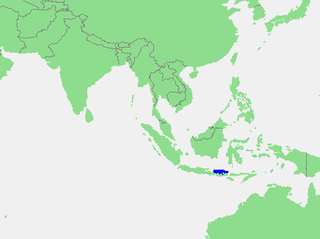
The Bali Sea is the body of water north of the island of Bali and south of Kangean Island in Indonesia. The sea forms the south-west part of the Flores Sea, and the Madura Strait opens into it from the west.

Asoriculus is an extinct genus of terrestrial shrews in the subfamily Soricinae and tribe Nectogalini. The best known species, Asoriculus gibberodon was widespread in Europe from the Late Miocene to the Early Pleistocene. Insular species are known from the Mediterranean islands of Sicily, and Corsica-Sardinia including A. corsicanus and A. similis. A. similis likely survived into the Holocene, when it became extinct after human settlement of the islands. The genus Nesiotites from the Balearic Islands, including the chronospecies N. rafelinensis, N. ponsi and N. hidalgo is considered to descend from Asoriculus, likely A. gibberodon. The insular species of Asoriculus from Sicily and Corsica-Sardinia were formerly included in Nesiotites, but Nesiotites was later circumscribed to only include the Balearic species, as otherwise the genus would likely be polyphyletic. The last Nesiotites chronospecies, N. hidalgo, became extinct shortly after human settlement of the Balearics around 2500 BC. Both the insular species of Asoriculus and Nesiotites are larger than A. gibberodon, which has been suggested to be the result of island gigantism, with the Nesiotites lineage experiencing a gradual increase in size over time. Based on DNA from Nesotites, and morphological similarities Asoriculus is considered to be most closely related to the Himalayan shrew (Soriculus). A molecular clock analysis suggests that Himalayan shrews and Balearic shrews diveraged approximately 6.44 million years ago.

The prehistory of Corsica is analogous to the prehistories of the other islands in the Mediterranean Sea, such as Sicily, Sardinia, Malta and Cyprus, which could only be accessed by boat and featured cultures that were to some degree insular; that is, modified from the traditional Paleolithic, Mesolithic, Neolithic and Chalcolithic of European prehistoric cultures. The islands of the Aegean Sea and Crete early developed Bronze Age civilizations and are accordingly usually treated under those categories. Stone Age Crete however shares some of the features of the prehistoric Mediterranean islands.

The Balearic Islands are a archipelago in the Balearic Sea, near the eastern coast of the Iberian Peninsula. The archipelago is an autonomous community and a province of Spain; its capital is Palma. The 2007 Statute of Autonomy designates the Balearic Islands as one of the nationalities of Spain. The official languages of the Balearic Islands are Catalan and Spanish.

Mawson Sea is a proposed sea name along the Queen Mary Land coast of East Antarctica east of the Shackleton Ice Shelf. West of it, on the western side of Shackleton Ice Shelf, would be the Davis Sea. To the east would be Bowman Island and Vincennes Bay.
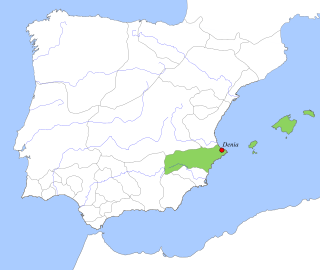
The taifa of Dénia was an Islamic kingdom in medieval Spain, ruling over part of the Valencian coast and Ibiza. With Dénia as its capital, the taifa included the Balearic Islands and parts of the Spanish mainland. It was founded in 1010 by the Slavic warlord Mujāhid al-ʿĀmirī.

The Nuragic civilization, also known as the Nuragic culture, was a civilization or culture on Sardinia (Italy), the second largest island in the Mediterranean Sea, which lasted from the 18th century BC up to the Roman colonization in 238 BC. Others date the culture as lasting at least until the 2nd century AD and in some areas, namely the Barbagia, to the 6th century AD or possibly even to the 11th century AD.

The borders of the oceans are the limits of Earth's oceanic waters. The definition and number of oceans can vary depending on the adopted criteria. The principal divisions of the five oceans are the Pacific Ocean, Atlantic Ocean, Indian Ocean, Southern (Antarctic) Ocean, and Arctic Ocean. Smaller regions of the oceans are called seas, gulfs, bays, straits, and other terms. Geologically, an ocean is an area of oceanic crust covered by water.
An Ottoman raid on the Balearic Islands occurred in 1501 under the Ottoman admiral Kemal Reis. This raid was combined with attacks on Sardinia and Pianosa.

Somov Sea was a proposed name for part of the Southern Ocean. It would be located north of the easternmost part of the Antarctic subcontinent East Antarctica, north of Oates Coast, Victoria Land, and of George V Coast, between 150° and 170° East. West of it would be the D'Urville Sea. East of Cape Adare, at 170°14' East, is the Ross Sea.


















